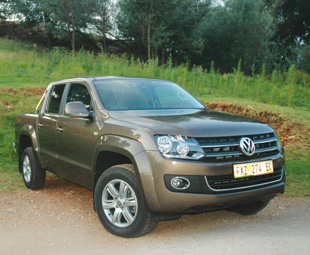Eight-speed wonder

Volkswagen’s Amarok has recently benefited from the addition of an eight-speed automatic transmission, GAVIN MYERS takes it for a spin to see how it gets on.
What can I say about the Volkswagen (VW) Amarok that we haven’t already said? Well, when the topic includes its new eight-speed automatic transmission, we can say quite a bit actually. Volkswagen South Africa (VWSA) introduced the option early in the year. Available only with the Bi-TDI engine in the double-cab body style, the new transmission opens the Amarok up to a whole new side of the market.
When we tested the manual version with the up-rated Bi-TDI engine in November last year, the overall impression was of a big, tough, no-nonsense (in a VW type of way, of course) bakkie. None of that has changed, except that it now features one of the best gearboxes available that makes the driving experience simply fantastic.
Much like VW’s double-clutch units fitted to other models, this conventional automatic box offers buttery smooth shifts, sometimes to the point of not being detectable. The gearbox offers three drive options: “D”, or traditional drive, in which gears are changed at the earliest possible convenience in the interests of fuel economy and an easy drive; “S”, or sporty gear selection, in which gears are held for a longer period of time to make the most of the available revs when, for example, towing or venturing off road; and “manual”, which is self explanatory,
 Despite the mode, the gearbox control software adapts to your driving style and there is really no need to use any other mode but “D”, especially around town. However, full-bore pull-offs can catch the box out as it will generally try to pull-off in second, and then take a moment to call upon first gear to blast off the line.
Despite the mode, the gearbox control software adapts to your driving style and there is really no need to use any other mode but “D”, especially around town. However, full-bore pull-offs can catch the box out as it will generally try to pull-off in second, and then take a moment to call upon first gear to blast off the line.
With VW’s superb, recently upgraded 132 kW, 420 Nm four-cylinder Bi-TDI engine, a brilliant combination propels you along in a relaxed, refined manner. Much like the gear changes being hardly detectable, it’s barely noticeable that a diesel powerplant is providing the motivation. The engine is perhaps the most quiet and smooth-revving in the business. With the automatic gearbox, VW claims that the Amarok’s towing capacity has been increased to three tonnes.
The automatic model is also fitted with VW’s permanent 4Motion four-wheel drive, providing good grip and handling and off-road ability. Again, the Amarok has perhaps the best rides of all double cab bakkies; the suspension is able to soak up anything the road throws at it without transmitting much back to the occupants.
Despite the Amarok’s commercial vehicle bent, the occupants will find as welcoming an interior as any VW can offer. Plastics are expectedly hard but of good quality, all controls fall easily to hand (OK, some radio controls might be a bit of a stretch), and the (cloth) seats are large and comfortable.
Our test car was fitted with the optional (R5 300) front and rear park distance control (PDC). In our November review, we remarked that these vehicles are becoming too big to be practical everyday. While we still feel that notion stands, the fitment of PDC does at least ease the headache of parking.
Electronic safety features fitted include anti-lock brakes, electronic brakeforce distribution, traction control (ESP still remains functional), a lockable differential and off-road and hill-decent control.
It’s relatively cheap to run too, VW claiming a fuel consumption figure of 8,3 l/100 km (219 g/km CO2 emissions), while offering a five-year/90 000 km service plan and a three-year/100 000 km warranty. With a standard list price of R461 100, the Amarok automatic is one of the most accomplished, refined and pleasurable bakkies one could buy.
Published by
Focus on Transport
focusmagsa




